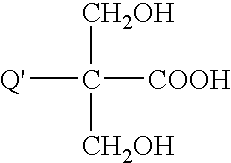Smear resistant inkjet inks
a technology of inkjet ink and smear resistance, which is applied in the field of inkjet inks, can solve the problems of increasing the viscosity of ink, prone to rub off, and prone to fade, and achieves good smear speed, good stability and jetting characteristics, and high optical density
- Summary
- Abstract
- Description
- Claims
- Application Information
AI Technical Summary
Benefits of technology
Problems solved by technology
Method used
Image
Examples
example 1
[0148]Inks were made according to the following recipes (Table 1). Amounts are in weight percent of the final ink; binders are quoted on a polyurethane solids basis.
[0149]
TABLE 1InventiveComparativeExample 1Example ASDP black6.56.5Hybridur ® 5800.10Mace 85-302-11.50Glycerol9.59.5Ethyleneglycol66Surfynol 4650.80.8WaterBalanceBalanceTOTAL100100
[0150]To a slurry of black SDP in deionized water was added, in order, the polyurethane dispersion binders (Hybridur® 580 and Mace 85-302-1), glycerol, ethylene glycol and Surfynol 465 surfactant. After mixing for 10–20 minutes, the pH was adjusted with triethanolamine to a final value of 8. The ink was then filtered through a 5 micron filter and degassed.
[0151]Patterns were printed and smear, water-fastness and optical density were determined as previously described. The highlighters used for the smear resistance tests are of different pH. HI-Liter #0774x has an acidic pH and HI-Liter #240xx has an alkaline pH. Results are as follows (Table 2)....
examples 2 – 5
Examples 2–5
[0153]Inks were made according to the following recipes (Table 3). Amounts are in weight percent of the final ink; binders are quoted on a solids basis. The binders listed were either available commercially or in the case of PU1 were prepared by the method described above. Binder 58 / 20 / 10 / 2 consists of 58% BZMA, 20% HEMA, 10% ETEGMA and 2% MMA.
[0154]
TABLE 3EX 2EX 3EX 4EX 5CEX CCEX DCEX ECEX FSDP black4444444458 / 20 / 10 / 120.50.50.50.5—10.50.5RP2———————0.5Vancryl ® 965——————0.5—Hybridur ® 580—0.5——————Mace 85-302-10.5———————Cydrothane ®——0.5—————HP5035PU1———0.5————Glycerol33333333Ethylene glycol44444444Surfynol 48511111111WaterBalanceBalanceBalanceBalanceBalanceBalanceBalanceBalanceTOTAL100100100100100100100100Viscosity(mPa · s)1.781.781.841.781.821.941.861.76Sur. Tens.41.6140.9841.2940.3550.4441.4264.7340.23(mN / m)
[0155]To a slurry of black SDP in deionized water was added, in order, the binder(s), glycerol, ethylene glycol and Surfynol 485 surfactant. After mixing for 10–20...
examples 6 – 9
Examples 6–9
[0168]Inks were made according to the following recipes (Table 7). Amounts are in weight percent of the final ink; binders are quoted on a solids basis. Each of these inks had a pH of 8.
[0169]
TABLE 7EX 6EX 7EX 8EX 9NIPEX 1806.56.56.56.5Glycerol8.38.38.38.3Ethylene Glycol99991,2-Hexanediol7.57.57.57.5EDTA3333Surfonyl 4851.21.21.21.2PU22———PU3—2——PU4——2—MACE 85-302-1———2WaterBalanceBalanceBalanceBalanceTOTAL100100100100Viscosity (mPa · s)2.642.642.682.44Sur. Tens. (mN / m)31.5432.5132.5832.90Conductivity 10−30.6190.9370.7010.657
The conductivity units are in mS (millisiemens) meter and the conductivity was measured by an Ecmeter.
[0170]
TABLE 8Acid #ChainParticle Size (microns)(theor.Neut.NCO:Ext.% onDegreeOHDegreePolyol204.4solids)(%)Ratio(%)typeMnMv10%50%nmPU220755 / 2.980PCPE0.1150.1410.09610.139594.47PU315705 / 4 89PCPE0.1250.1460.1050.14495.05PU420755 / 4 75PCPE0.0590.0700.0500.06899.99MACE201 / 1 0.830.3020.0840.3025.9985-302-1PCPE = Polycarbonate polyester
[0171]To a slurry of...
PUM
| Property | Measurement | Unit |
|---|---|---|
| viscosity | aaaaa | aaaaa |
| surface tension | aaaaa | aaaaa |
| Tg | aaaaa | aaaaa |
Abstract
Description
Claims
Application Information
 Login to View More
Login to View More - R&D
- Intellectual Property
- Life Sciences
- Materials
- Tech Scout
- Unparalleled Data Quality
- Higher Quality Content
- 60% Fewer Hallucinations
Browse by: Latest US Patents, China's latest patents, Technical Efficacy Thesaurus, Application Domain, Technology Topic, Popular Technical Reports.
© 2025 PatSnap. All rights reserved.Legal|Privacy policy|Modern Slavery Act Transparency Statement|Sitemap|About US| Contact US: help@patsnap.com

